Tire SUZUKI JIMNY 2019 Owners Manual
[x] Cancel search | Manufacturer: SUZUKI, Model Year: 2019, Model line: JIMNY, Model: SUZUKI JIMNY 2019Pages: 421, PDF Size: 6.35 MB
Page 26 of 421
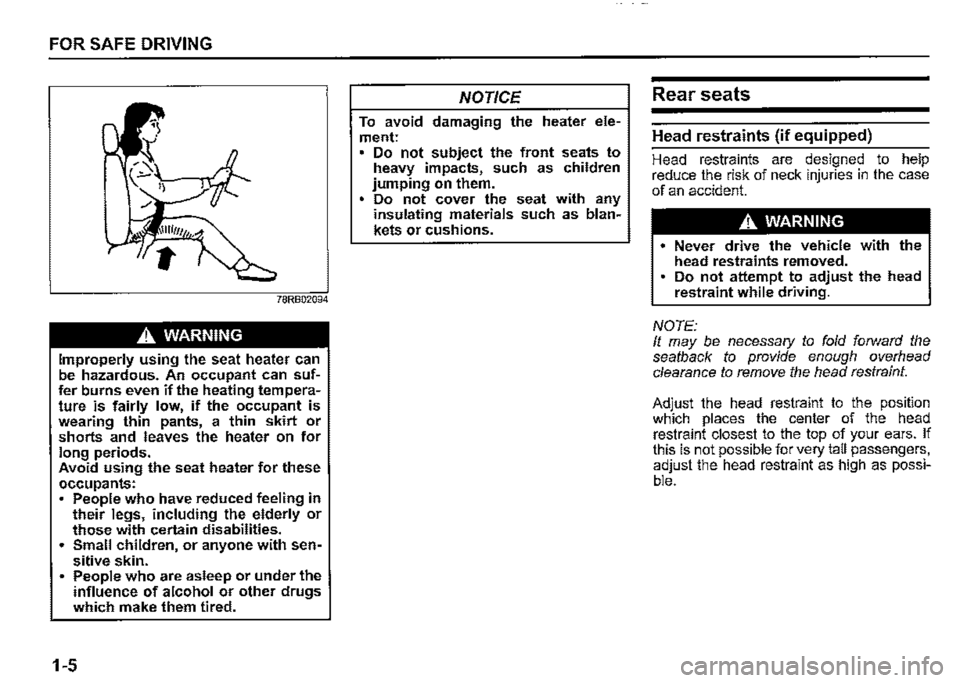
FOR SAFE DRIVING
A WARNING
Improperly using the seat heater can be hazardous. An occupant can suffer burns even if the heating temperature is fairly low, if the occupant is wearing thin pants, a thin skirt or shorts and leaves the heater on for long periods. Avoid using the seat heater for these occupants: People who have reduced feeling in their legs, including the elderly or those with certain disabilities. • Small children, or anyone with sensitive skin. • People who are asleep or under the influence of alcohol or other drugs which make them tired.
1-5
NOTICE
To avoid damaging the heater element: • Do not subject the front seats to heavy impacts, such as children jumping on them. Do not cover the seat with any insulating materials such as blankets or cushions.
Rear seats
Head restraints (if equipped)
Head restraints are designed to help reduce the risk of neck injuries in the case of an accident.
A WARNING
Never drive the vehicle with the head restraints removed. Do not attempt to adjust the head restraint while driving.
NOTE: It may be necessary to fold forward the seatback to provide enough overhead clearance to remove the head restraint.
Adjust the head restraint to the position which places the center of the head restraint closest to the top of your ears. If this is not possible for very tall passengers, adjust the head restraint as high as possible.
Page 30 of 421
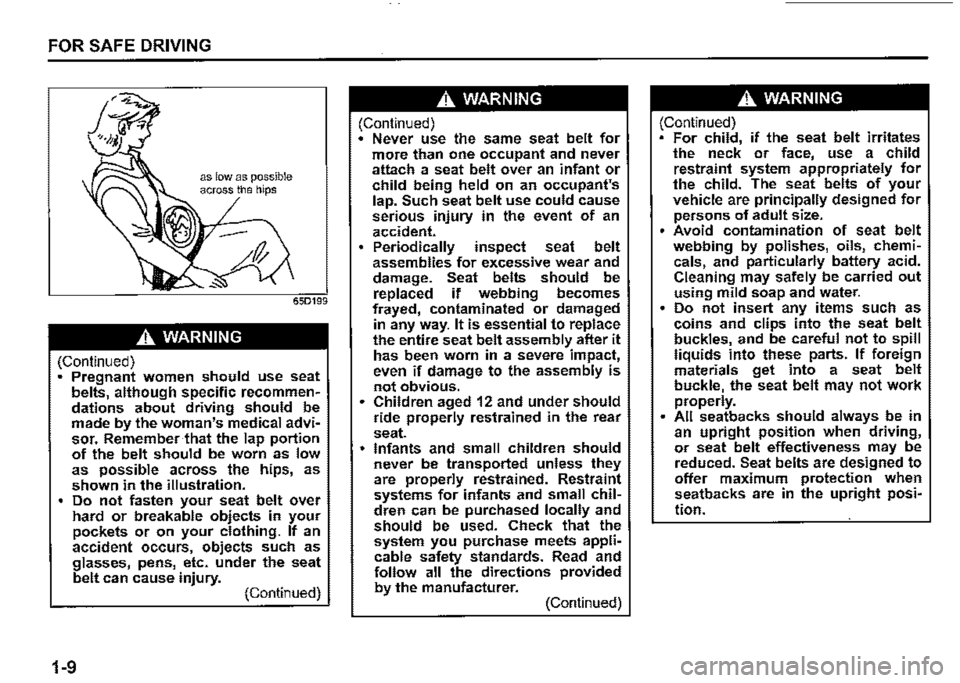
FOR SAFE DRIVING
A. WARNING
(Continued) Pregnant women should use seat belts, although specific recommendations about driving should be made by the woman's medical advi• sor. Remember that the lap portion of the belt should be worn as low as possible across the hips, as shown in the illustration. Do not fasten your seat belt over hard or breakable objects in your pockets or on your clothing. If an accident occurs, objects such as glasses, pens, etc. under the seat belt can cause injury. (Continued)
1-9
A. WARNING
(Continued) • Never use the same seat belt for more than one occupant and never attach a seat belt over an infant or child being held on an occupant's lap. Such seat belt use could cause serious injury in the event of an accident. Periodically inspect seat belt assemblies for excessive wear and damage. Seat belts should be replaced if webbing becomes frayed, contaminated or damaged in any way. It is essential to replace the entire seat belt assembly after it has been worn in a severe impact, even if damage to the assembly is not obvious. Children aged 12 and under should ride properly restrained in the rear seat. Infants and small children should never be transported unless they are properly restrained. Restraint systems for infants and small chil• dren can be purchased locally and should be used. Check that the system you purchase meets appli• cable safety standards. Read and follow all the directions provided by the manufacturer. (Continued)
A. WARNING
(Continued) For child, if the seat belt irritates the neck or face, use a child restraint system appropriately for the child. The seat belts of your vehicle are principally designed for persons of adult size. Avoid contamination of seat belt webbing by polishes, oils, chemi• cals, and particularly battery acid. Cleaning may safely be carried out using mild soap and water. • Do not insert any items such as coins and clips into the seat belt buckles, and be careful not to spill liquids into these parts. If foreign materials get into a seat belt buckle, the seat belt may not work properly. All seatbacks should always be in an upright position when driving, or seat belt effectiveness may be reduced. Seat belts are designed to offer maximum protection when seatbacks are in the upright posi•
tion.
Page 206 of 421
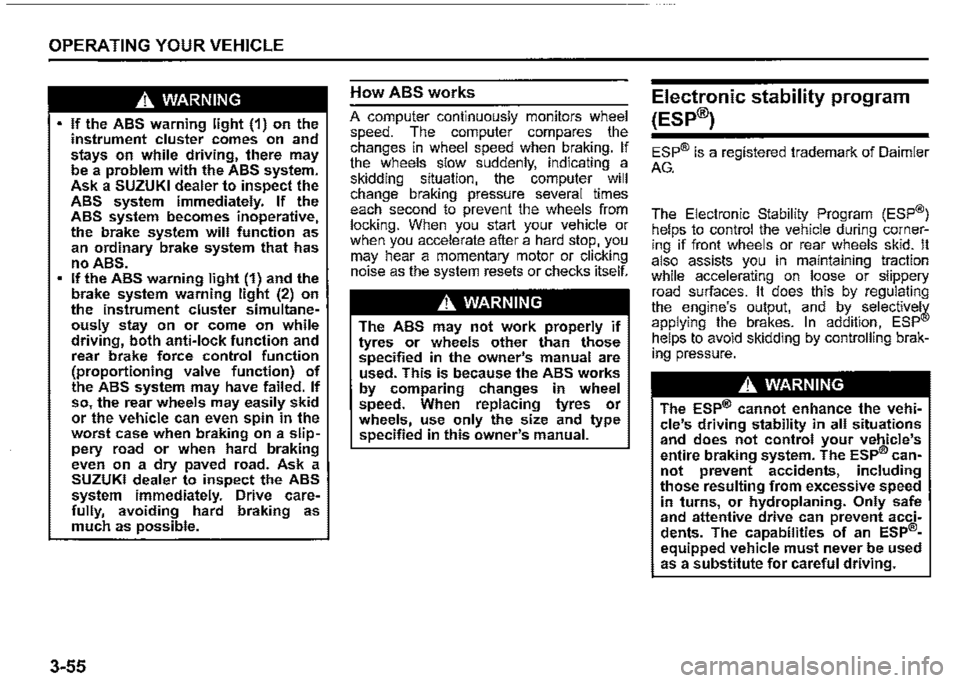
OPERATING YOUR VEHICLE
A WARNING
If the ABS warning light (1) on the instrument cluster comes on and stays on while driving, there may be a problem with the ABS system. Ask a SUZUKI dealer to inspect the ABS system immediately. If the ABS system becomes inoperative, the brake system will function as an ordinary brake system that has no ABS. If the ABS warning light (1) and the brake system warning light (2) on the instrument cluster simultaneously stay on or come on while driving, both anti-lock function and rear brake force control function (proportioning valve function) of the ABS system may have failed. If so, the rear wheels may easily skid or the vehicle can even spin in the worst case when braking on a slippery road or when hard braking even on a dry paved road. Ask a SUZUKI dealer to inspect the ABS system immediately. Drive carefully, avoiding hard braking as much as possible.
3-55
How ABS works
A computer continuously monitors wheel speed. The computer compares the changes in wheel speed when braking. If the wheels slow suddenly. indicating a skidding situation, the computer will change braking pressure several times each second to prevent the wheels from locking. When you start your vehicle or when you accelerate after a hard stop. you may hear a momentary motor or clicking noise as the system resets or checks itself.
A WARNING
The ABS may not work properly if tyres or wheels other than those specified in the owner's manual are used. This is because the ABS works by comparing changes in wheel speed. When replacing tyres or wheels, use only the size and type specified in this owner's manual.
Electronic stability program
(ESP®)
ESP® is a registered trademark of Daimler
AG.
The Electronic Stability Program (ESP®) helps to control the vehicle during cornering if front wheels or rear wheels skid. It also assists you in maintaining traction while accelerating on loose or slippery road surfaces. It does this by regulating the engine's output, and by_ . selective!¥ applying the brakes. In add1t1on, ESP helps to avoid skidding by controlling braking pressure.
A WARNING
The ESP® cannot enhance the vehicle's driving stability in all situations and does not control your vehicle's entire braking system. The ESP® cannot prevent accidents, including those resulting from excessive speed in turns, or hydroplaning. Only safe and attentive drive can prevent accidents. The capabilities of an ESP®
equipped vehicle must never be used as a substitute for careful driving.
Page 225 of 421
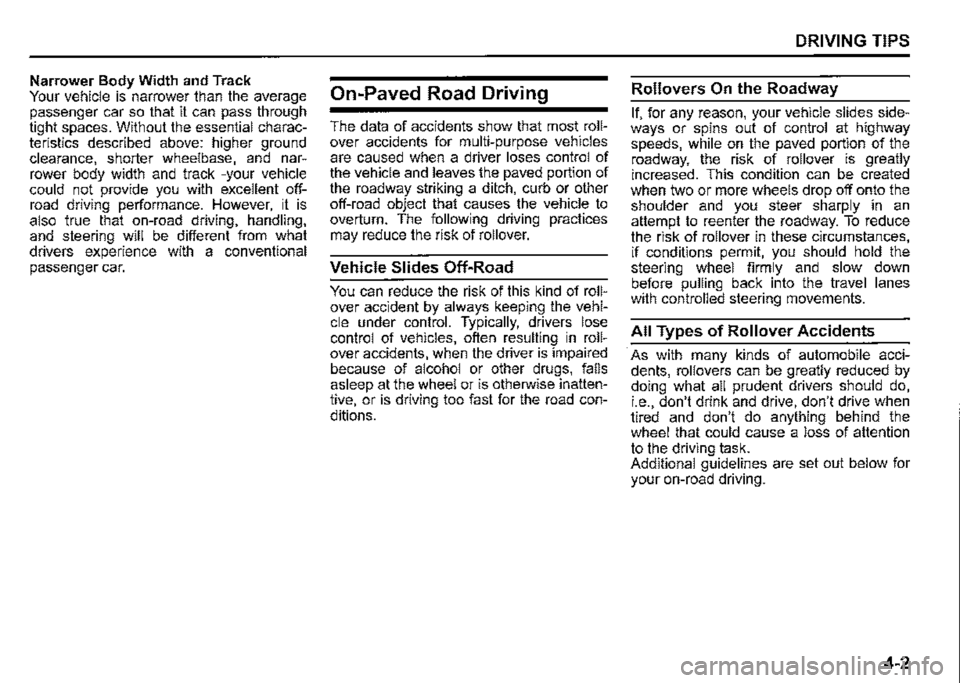
Narrower Body Width and Track Your vehicle is narrower than the average passenger car so that it can pass through tight spaces. Without the essential characteristics described above: higher ground clearance, shorter wheelbase, and narrower body width and track -your vehicle could not provide you with excellent offroad driving performance. However, it is also true that on-road driving, handling, and steering will be different from what drivers experience with a conventional passenger car.
On-Paved Road Driving
The data of accidents show that most rollover accidents for multi-purpose vehicles are caused when a driver loses control of the vehicle and leaves the paved portion of the roadway striking a ditch, curb or other off-road object that causes the vehicle to overturn. The following driving practices may reduce the risk of rollover.
Vehicle Slides Off-Road
You can reduce the risk of this kind of rollover accident by always keeping the vehicle under control. Typically, drivers lose control of vehicles, often resulting in rollover accidents, when the driver is impaired because of alcohol or other drugs, falls asleep at the wheel or is otherwise inattentive, or is driving too fast for the road con
ditions.
DRIVING TIPS
Rollovers On the Roadway
If, for any reason, your vehicle slides sideways or spins out of control at highway speeds, while on the paved portion of the roadway, the risk of rollover is greatly increased. This condition can be created when two or more wheels drop off onto the shoulder and you steer sharply in an attempt to reenter the roadway. To reduce the risk of rollover in these circumstances, if conditions permit, you should hold the steering wheel firmly and slow down before pulling back into the travel lanes with controlled steering movements.
All Types of Rollover Accidents
· As with many kinds of automobile accidents, rollovers can be greatly reduced by doing what all prudent drivers should do, i.e., don't drink and drive, don't drive when tired and don't do anything behind the wheel that could cause a loss of attention to the driving task. Additional guidelines are set out below for your on-road driving.
4-2
Page 394 of 421

APPEARANCE CARE
Washing by hand
,r l'J J,
r,
60B212S
When washing the vehicle, park it in the place where direct sunlight does not fall on it as much as possible and follow the instructions below: 1) Flush the underside of body and wheel housings with pressurized water to remove mud and debris. Use plenty of water.
NOTICE
When washing the vehicle: • Avoid directing steam or hot water of more than 80°C (176°F) on plastic parts. To avoid damaging engine components, do not use pressurized water in the engine compartment.
8-5
2) Rinse the body to loosen the dirt. Remove dirt and mud from the body exterior with running water. You may use a soft sponge or brush. Do not use hard materials which can scratch the . paint or plastic. Remember that the headlight covers or lenses are made of plastic in many cases.
NOTICE
To avoid damage to the paint or plastic surface, do not wipe the dirt off without ample water. Follow the above procedure.
3) Wash the entire exterior with a mild detergent or car wash soap using a sponge or soft cloth. The sponge or cloth should be frequently soaked in the soap solution.
NOTICE
When using a commercial car wash product, observe the cautions specified by the manufacturer. Never use strong household detergents or soaps.
4) Once the dirt has been completely removed, rinse off the detergent with running water. 5) Wipe off the vehicle body with a wet chamois or cloth and allow it to dry in the shade.
6) Check carefully for damage to painted surfaces. If there is any damage, touch up the damage following the procedure below: 1. Clean all damaged spots and allow them to dry. 2. Stir the paint and touch up the damaged spots lightly using a small brush. 3. Allow the paint to dry completely.
Washing by an automatic car wash
NOTICE
If you use an automatic car wash, check that your vehicle's body parts, such as spoilers, cannot be damaged. If you are in doubt, consult the car wash operator for advice.
Page 410 of 421

SUPPLEMENT
If you must use a front-facing child restraint in the front passenger's seat, be sure to move the front passenger's seat as far back as possible. Please refer to "Seat belts and child restraint systems" in the "BEFORE DRIVING" section for details on securing your child.
Airbag symbol meaning
A (ill
AIRBAG ~
®
@~
72M00150
You may find this label on the sun visor.
A WARNING
NEVER use a rearward facing child restraint on a seat protected by an ACTIVE AIRBAG in front of it, DEATH or SERIOUS INJURY to the CHILD can occur.
10-3
Seat belt warning
Follow this warning as well as the instruction for seat belt in this book.
A WARNING
Seat belts are designed to bear upon the bony structure of the body, and should be worn low across the front of the pelvis or the pelvis, chest and shoulders, as applicable; wearing the lap section of the belt across the abdominal area must be avoided. • Seat belts should be adjusted as firmly as possible, consistent with comfort, to provide the protection for which they have been designed. A slack belt will greatly reduce the protection afforded to the wearer. • Care should be taken to avoid contamination of the webbing with polishes, oils and chemicals, and particularly battery acid. Cleaning may safely be carried out using mild soap and water. The belt should be replaced if webbing becomes frayed, contaminated or damaged. (Continued)
A WARNING
(Continued) • It is essential to replace the entire assembly after it has been worn in a severe impact even if damage to the assembly is not obvious. Belts should not be worn with straps twisted. Each belt assembly must only be used by one occupant; it is dangerous to put a belt around a child being carried on the occupant's lap,
In the case where a "Seat Belt Assembly'' incorporates an "Automatic Length Adjusting and Locking Retractor' or an "Emergency Locking Retractor'.
A WARNING
No modifications or additions should be made by the user which will either prevent the seat belt adjusting devices from operating to remove slack, or prevent the seat belt assembly from being adjusted to remove slack. Referring to the SEAT BELT instruction in this book, adjust the seat belt so that the lap and sash portions of the Seat Belt Assembly fit as firmly as possible consistent with comfort.
Page 419 of 421
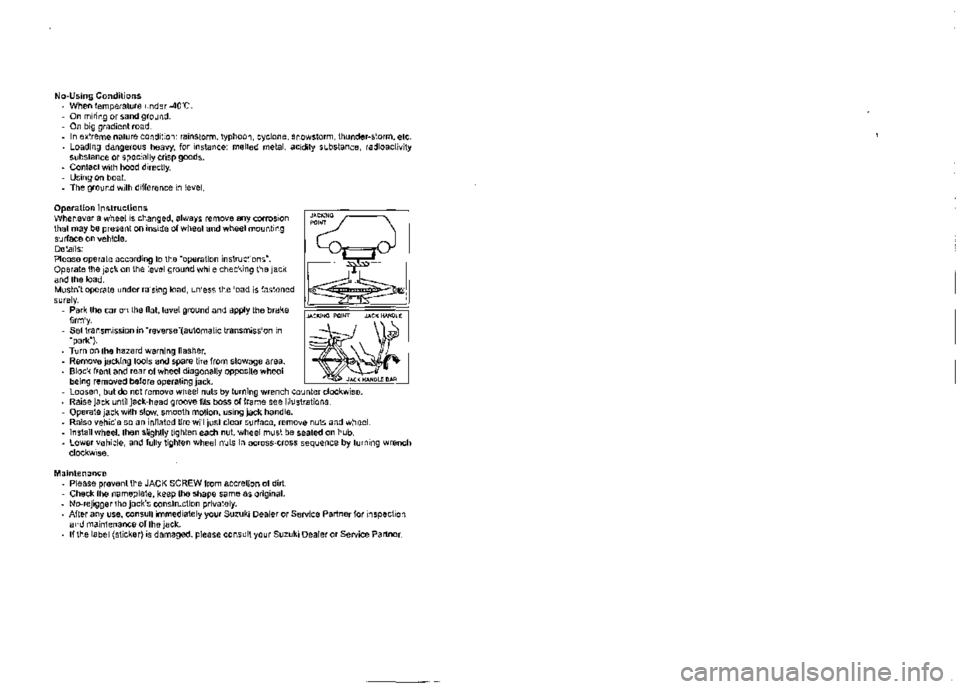
No.Using Conditions • When temperature under -40-C . • On miring or sand ground . • On big gradient road . • In extreme nature condition: rainstorm, typhoon, cyclone, snowstorm, thunder•storm. etc . • Loading dangerous heavy, for instance: melted metal. acidity substance, radioactivity substance or specially crisp goods • • Contact with hood directly . • Using on boat. • The ground with difference in level.
Operation Instructions Whenever a wheel is changed, always remove any corrosion that may be present on inside of wheel and wheel mounting surface on vehicle. Details: Please operate according to the "operation instructions", Operate the jack on the level ground while checking the jack and the load. Musln"I operate under raising load, unless the load is fastened surely . • Park the car on the nat, love ground and apply the brake firmly. • Set transmission in "reverse"(automalic transmission in ·park") . • Turn on the hazard warning Hasher . • Remove jacklng tools and spare tire from stowage area . • Block fFont and rear of wheel diagonally opposlte wheel being removed before operating jack .
~
ITT
~ .s,.Cl(Jf>Of'(llITT J-'CKIW
Maintenance • Please prevent the JACK SCREW from accretion of dirt . • Check the nameplate, keep the shape same as original. • No-re jigger the Jack's construction privately . • After any use, consult immediately your Suzuki Dealer or Service Partner for inspection and maintenance of the jack . • If the label (slicker) is damaged, pt ease consult your Suzuki Dealer or Service Partner.
Page 421 of 421
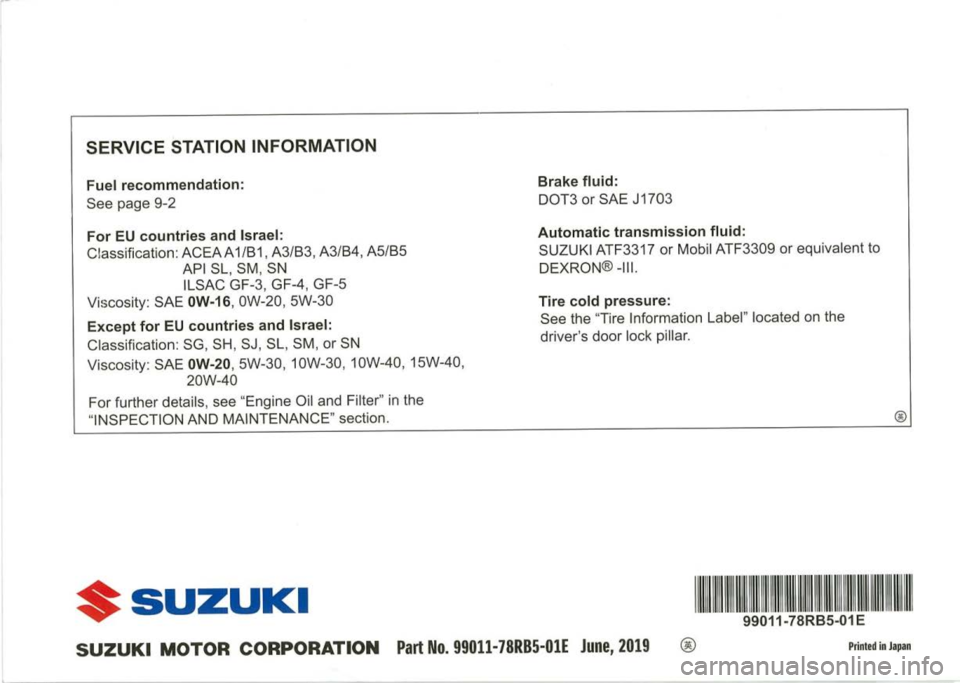
SERVICE STATION INFORMATION
Fuel recommendation:
See page 9-2
For EU countries and Israel:
Classification: ACEAA1/B1, A3/B3, A3/B4, A5/B5
API SL, SM, SN
ILSAC GF-3, GF-4, GF-5
Viscosity: SAE 0W-16, 0W-20, 5W-30
Except for EU countries and Israel:
Classification: SG, SH, SJ, SL, SM, or SN
Viscosity: SAE 0W-20, 5W-30, 1 0W-30, 1 0W-40, 1 SW-40,
20W-40
For further details, see "Engine Oil and Filter" in the
"INSPECTION AND MAINTENANCE" section.
$SUZUKI
Brake fluid:
DOT3 or SAE J1703
Automatic transmission fluid:
SUZUKI ATF3317 or Mobil ATF3309 or equivalent to
DEXRON® -Ill.
Tire cold pressure:
See the "Tire Information Label" located on the
driver's door lock pillar.
llllllllllllllllllllllllllllllllllllllllllllllllllllllllllllllllllllllllllllllllllllllllll 99011-78RB5-01 E
SUZUKI MOTOR CORPORATION Part No. 99011-78RB5-01E June, 2019 Printed in Japan